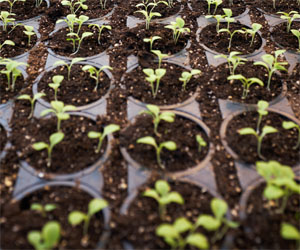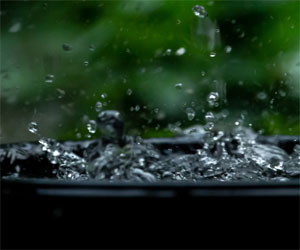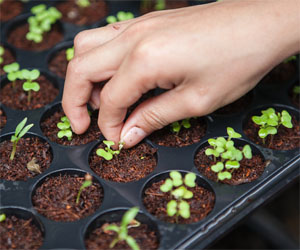


Turning Scraps Into Garden Gold

Composting is a natural recycling process that transforms organic materials, such as kitchen scraps and yard waste, into nutrient-rich, humus-like material known as compost. This "black gold" is a gardener's best friend, enhancing soil fertility, reducing waste, and contributing to a sustainable lifestyle. In this article, we'll explore the world of composting, its benefits, and how you can get started.
The Benefits Of Composting
Fertilizes Your Garden: Compost is a nutrient powerhouse. It enriches soil with essential macronutrients (nitrogen, phosphorus, potassium) and micronutrients, providing a well-balanced diet for your plants.
Improves Soil Structure: Compost acts as a natural soil conditioner, making heavy clay soils lighter and sandy soils more water-retentive. It enhances soil structure and aeration, promoting healthier root development.
Enhances Water Retention: Compost increases the soil's water-holding capacity, reducing the need for frequent watering in your garden.
Suppresses Plant Diseases: Compost contains beneficial microorganisms that can help prevent soil-borne diseases and reduce the need for chemical pesticides.
Reduces Waste: Composting diverts kitchen and yard waste from landfills, reducing the production of harmful methane gas and lessening the burden on waste disposal systems.
Getting Started With Composting
Select A Composting Location: Choose a suitable spot in your garden or yard for your compost bin or pile. It should be well-drained and accessible for regular turning.
Collect Compostable Materials: Gather kitchen scraps (fruit and vegetable peels, coffee grounds, eggshells), yard waste (leaves, grass clippings, small branches), and other organic materials (paper, cardboard). Avoid meat, dairy, and diseased plants, as these can attract pests and pathogens.
Layer The Materials: Alternate between green (nitrogen-rich) and brown (carbon-rich) materials in your compost pile. This balance provides the right C:N ratio (carbon to nitrogen) for efficient decomposition.
Aerate And Turn: Regularly turn your compost pile with a pitchfork or aeration tool to introduce oxygen and promote decomposition. A well-aerated pile minimizes unpleasant odors and speeds up the composting process.
Maintain Moisture: Keep your compost pile moist but not waterlogged. If it becomes too dry, it won't decompose effectively. If it's too wet, it can become smelly and anaerobic.
Monitor Temperature: A well-working compost pile will generate heat as microorganisms break down the organic matter. This is a sign that your compost is active and efficient.
Harvest Your Compost: In a few months to a year, depending on the size of your pile and the materials used, your compost will be ready. It should look like dark, crumbly, earthy-smelling soil. You can use it to amend garden soil, potting mixes, or as mulch.
Composting Tips
Avoid adding diseased or insect-infested plant material to your compost.
To deter pests, consider using a secure, lidded compost bin.
Be mindful of what you add to your compost. Some materials, like pet waste or treated wood, should be avoided.
Chop or shred large materials like branches and cardboard to speed up decomposition.
Be patient; composting is a gradual process.
Composting is a simple yet effective way to reduce waste, enrich your garden, and promote sustainable living. By embracing the art and science of composting, you can play a vital role in reducing your environmental footprint while nurturing healthier, more productive plants.
The Liberating Power Of Minimalism
 The modern consumerist culture often bombards us with messages that more is better, and that happiness can be found through the acquisition of material possessions. However, this mindset can lead to cluttered lives, financial strain, and a sense of emptiness. "Freedom from excess" challenges this narrative, offering a different perspective on what constitutes a fulfilling life.
The modern consumerist culture often bombards us with messages that more is better, and that happiness can be found through the acquisition of material possessions. However, this mindset can lead to cluttered lives, financial strain, and a sense of emptiness. "Freedom from excess" challenges this narrative, offering a different perspective on what constitutes a fulfilling life.
Here are some key aspects of this philosophy:
Minimalist Living: At its core, "freedom from excess" aligns with minimalist living. It encourages individuals to declutter their living spaces, reduce their material possessions, and focus on the essentials that truly add value to their lives. Minimalist living emphasizes quality over quantity and promotes the idea that less can be more.
Financial Freedom: A focus on "freedom from excess" includes mindful spending and the avoidance of unnecessary debt. By living within one's means and reducing unnecessary expenses, individuals can experience financial freedom, reduce stress, and achieve greater control over their financial future.
A Path To Sustainability And Well-Being
 Harmony with nature is not merely an abstract ideal; it is a practical and philosophical approach to life that has profound implications for our environment, mental well-being, and the future of our planet.
Harmony with nature is not merely an abstract ideal; it is a practical and philosophical approach to life that has profound implications for our environment, mental well-being, and the future of our planet.
At its core, harmony with nature emphasizes the interconnectedness of all living things. It acknowledges that humans are not separate from the environment but an integral part of it. When we live in harmony with nature, we treat the Earth and its resources with respect, realizing that our actions have consequences not only for the planet but for future generations.
One of the fundamental principles of harmonious living is sustainability. This means using resources responsibly, minimizing waste, and conserving energy.
Streamline Your Space And Simplify Your Life

1. Start Small
One of the most common mistakes when tackling clutter is trying to do too much at once. Start with a small area, like a drawer, a shelf, or a single closet. Completing one small area can give you a sense of accomplishment and motivate you to continue.
2. The One-Year Rule
If you haven't used or needed an item within the last year, consider whether it's truly necessary in your life. Apply the one-year rule when decluttering. If you haven't touched it in that time, it may be time to let it go.
3. Declutter By Category
Organize your decluttering efforts by category, not by room. For example, gather all your books, clothing, or kitchen items in one place and go through them systematically. This approach allows you to see the full extent of your possessions in that category.
4. Use The Four-Box Method
When decluttering a space, use the four-box method: one box for items to keep, one for items to donate, one for items to sell, and one for items to discard. This method helps you make decisions quickly and efficiently.
5. Minimalism In Mind
Embrace a minimalist mindset by focusing on quality over quantity. Ask yourself if you truly need multiple versions of the same item or if one well-made item will suffice. Reducing duplicates is a quick way to declutter.
Cultivating A Sustainable Green Space
 Benefits Of Eco-Friendly Gardening:
Benefits Of Eco-Friendly Gardening:
Reduced Environmental Impact: One of the primary advantages of eco-friendly gardening is its ability to reduce the negative impact on the environment. By avoiding harmful chemical pesticides and synthetic fertilizers, you help protect the soil, water, and air from pollution.
Biodiversity: Eco-friendly gardening practices encourage the presence of diverse plant and animal species in your garden. This not only adds to the beauty of your green space but also contributes to local biodiversity and ecosystem health.
Sustainability: Sustainable gardening prioritizes renewable resources and practices, ensuring the long-term health and productivity of your garden. Composting, mulching, and water conservation are key elements of this approach.
Healthier Garden: By avoiding harsh chemicals, your garden becomes a healthier place for plants, insects, and people. Organic gardening methods promote the use of natural predators to control pests, resulting in a balanced and thriving ecosystem.
Cost-Effective: Eco-friendly gardening can be cost-effective in the long run. While initial investments in organic soil amendments and composting may be slightly higher, the reduced need for chemical inputs and lower maintenance costs can offset these expenses over time.
Principles Of Eco-Friendly Gardening:
Natural Pest Control: Encourage beneficial insects like ladybugs and lacewings, and use natural remedies like neem oil to combat garden pests.
Organic Soil Enrichment: Improve soil health with compost and organic matter, reducing the need for synthetic fertilizers.






Simplifying Life In The Modern World
 Defining Convenience Solutions
Defining Convenience Solutions
Convenience solutions are innovations that aim to eliminate or reduce the hassles and inconveniences we encounter in our everyday lives. They encompass a broad spectrum of offerings, from mobile apps and smart devices to delivery services and automation technologies. The overarching goal is to enhance our overall quality of life by minimizing the effort required to accomplish various tasks.
Home Automation
One of the most prominent categories within convenience solutions is home automation. Smart devices and systems are designed to control and manage various aspects of daily living. This includes intelligent thermostats that optimize heating and cooling, smart locks that enhance security, and voice-activated virtual assistants that can answer questions and perform tasks with simple commands. Home automation makes daily life more comfortable and efficient.
Meal Delivery Services
Convenience solutions have revolutionized meal preparation. Meal delivery services, such as Blue Apron, HelloFresh, and DoorDash, provide ready-to-cook meal kits and restaurant food delivered right to your doorstep. These services save time, reduce the need for grocery shopping, and offer a variety of dining options without leaving the comfort of your home.
Strategies And Implications
 Higher yields in agriculture refer to the increased production of crops, livestock, or other agricultural products per unit of land, water, or other resources. This increase in productivity is essential for several reasons:
Higher yields in agriculture refer to the increased production of crops, livestock, or other agricultural products per unit of land, water, or other resources. This increase in productivity is essential for several reasons:
1. Food Security: With a global population that continues to expand, the need for increased food production is evident. Higher yields help ensure that there is enough food to feed everyone.
2. Economic Growth: Agriculture is a significant driver of economic growth in many countries. Higher yields can boost rural economies, create jobs, and increase income for farmers and agricultural businesses.
3. Environmental Sustainability: Efficient farming practices that result in higher yields can help reduce the environmental impact of agriculture. By producing more food with fewer resources, we can minimize habitat destruction, water usage, and greenhouse gas emissions.
Strategies For Achieving Higher Yields
Numerous strategies and technologies contribute to higher yields in agriculture:
1. Improved Crop Varieties: Developing and adopting high-yielding crop varieties through selective breeding and genetic modification is a primary strategy. These varieties are often more disease-resistant and better suited to specific environmental conditions.
2. Precision Agriculture: The use of technology, such as GPS, sensors, and data analysis, allows farmers to make precise decisions about planting, irrigation, and fertilization. This optimizes resource use and boosts yields.
3. Sustainable Practices: Techniques like crop rotation, reduced tillage, and cover cropping can improve soil health and enhance crop yields while minimizing environmental harm.
4. Efficient Water Management: Implementing water-saving irrigation methods like drip or sprinkler systems can help maintain optimal soil moisture and boost crop yields.
5. Pest And Disease Management: Effective pest and disease control measures, including integrated pest management, help protect crops and prevent yield losses.